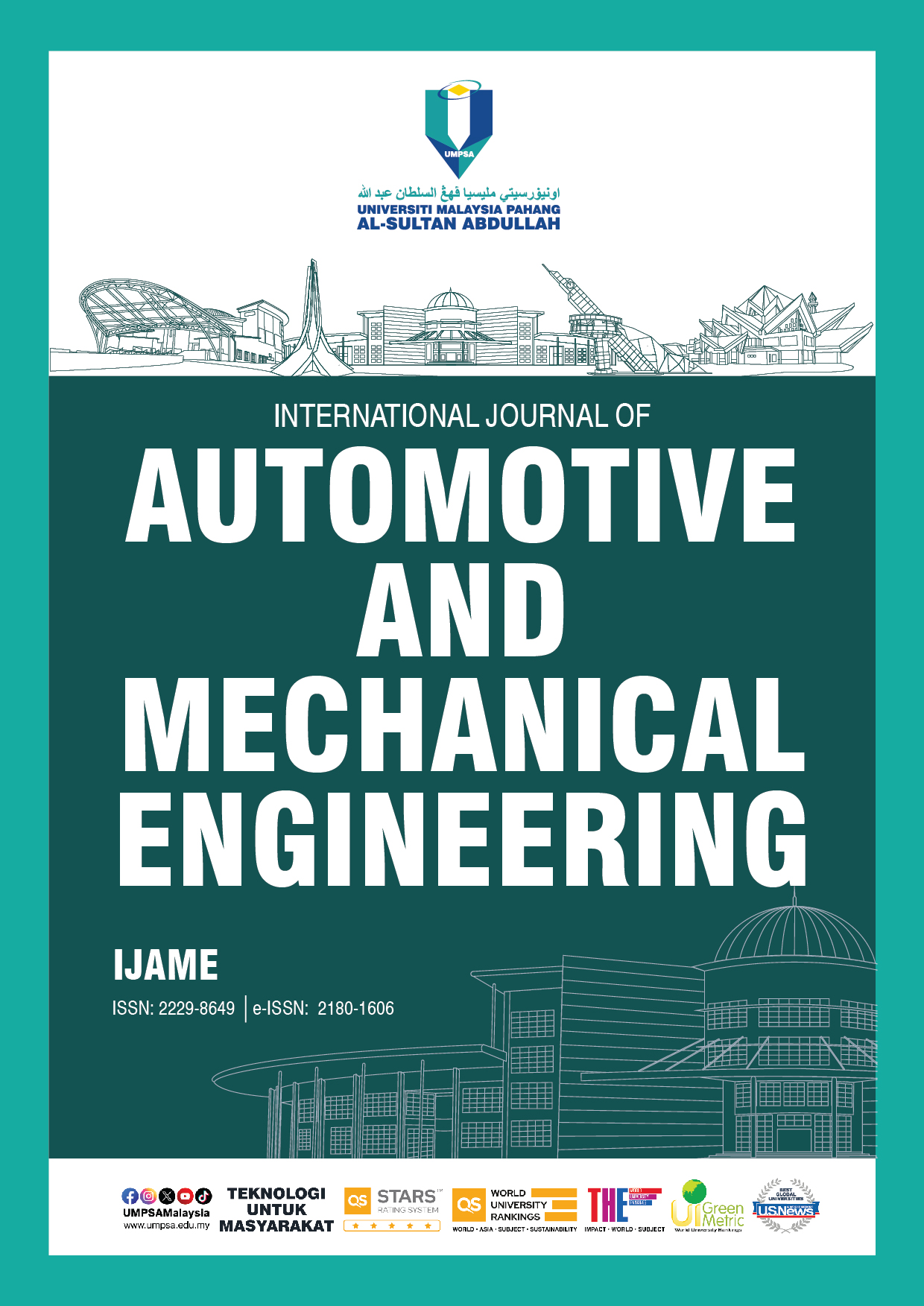Comparative Study on the Protective Performance of Typical Child Safety Seats Based on Experiments
DOI:
https://doi.org/10.15282/ijame.22.2.2025.12.0949Keywords:
Child restraint system (CRS), 5-point harness, 6-point harness, Child safety seat, Child occupant protectionAbstract
With the continued rise in global vehicle ownership, the safety of child occupants has garnered increasing research attention. However, United Nations Regulation No. 129 (UN R129) currently lacks injury assessment criteria for the crotch region—specifically, the perineal area and anterior pelvic soft tissues—primarily due to the absence of dedicated sensors in existing child anthropomorphic test devices (ATDs). To address this limitation, the present study proposes a qualitative evaluation method by placing quail eggs, chicken eggs, and modeling clay in the crotch region of a 3-year-old child dummy in order to observe deformation responses under crash loading. Comparative tests were conducted on child restraint systems featuring 5-point and 6-point harness configurations under frontal/lateral impact and overturning conditions in accordance with UN R129 protocols. The results indicate that the 6-point harness system significantly reduces soft tissue compression and mitigates the risk of pelvic injury during frontal impacts while also improving control of dummy kinematics in lateral impact and overturning scenarios. Overall, the 6-point harness demonstrated superior protective performance compared to the conventional 5-point system. These findings underscore the critical need to enhance protective measures for the perineal and lower pelvic regions in child occupants. The study further advocates for the development of child ATDs equipped with high-resolution crotch-area sensors and recommends integrating computational simulations with physical testing to establish a robust quantitative framework for evaluating injuries in the crotch region.
References
[1] World Health Organization, Global Status Report on Road Safety 2018, Geneva: WHO, 2018. [Online]. Available: https://www.who.int/publications/i/item/9789241565684.
[2] Guokr, “A child dummy costing 100 million yuan tells you what a child will experience in a car accident,” YouTube, Jun. 28, 2020. [Online]. Available: https://www.youtube.com/watch?v=s-TSWB9uthE.
[3] Y. Tanaka, H. Yonezawa, N. Hosokawa, Y. Matsui, K. Mizuno, M. Yamaguchi, et al., “Responses of Hybrid III 3YO and Q3 dummies in various CRSs tested using ECE R44 impact conditions,” in The 21th International Technical Conference on the Enhanced Safety of Vehicles (ESV), pp. 15-18. 2009.
[4] Y. Han, D. Pan, J. Ouyang, L. Qian, K. Mizuno, and A. Cang, “Study of chest injuries to 3-year-old child occupants seated in impact shield and 5-point harness CRSs,” Traffic Injury Prevention, vol. 19, no. 3, pp. 274–279, 2018.
[5] Y. Ahmad, K. A. A. Kassim, M. H. M. Isa, and S. Mustaffa, “A comparison between Isofix and seatbelt installation methods for child restraint system on child occupant performance,” Journal of Mechanical Engineering, vol. 1, pp. 131–141, 2018.
[6] X. Zhang and Y. Niu, “Research on general layout parameters of I-SIZE child safety seat in frontal impact,” International Journal of Crashworthiness, vol. 27, no. 4, pp. 968–978, 2022.
[7] H. Li, W. Lv, L. Hynčík, B. Zhou, H. Zhao, S. Cui, et al., “Injury study of the 6-year-old pediatric thorax and abdomen in frontal sled tests using different computational models,” Frontiers in Future Transportation, vol. 3, p. 890776, 2022.
[8] J. Mansfield, Y. Kang, and J. Bolte, “Rear-facing child restraint systems in rear impact sled tests,” SAE Technical Paper 2018-01-1325, 2018.
[9] J. Mansfield, “Comparison of child restraint system (CRS) installation methods and misuse during far-side impact sled testing,” SAE Technical Paper 2023-01-0817, 2023.
[10] J. Mansfield and Y. Kang, “Effects of adjacent vehicle seat positions on child restraint system (CRS) performance in far-side impacts,” SAE Technical Paper 2022-01-0848, 2022.
[11] J. Maheshwari, M. Griffith, G. Baker, D. Patton, and J. Mansfield, “Effect of naturalistic seating postures and seatbelt routing on booster-seated Q6 ATD kinematics and kinetics in frontal impacts,” Accident Analysis & Prevention, vol. 189, p. 107140, 2023.
[12] X. Zhang, J. Gao, and W. Tu, “Parameter study for child booster seats in frontal collisions,” Applied Sciences, vol. 13, no. 4, p. 2206, 2023.
[13] X. Jiang and X. Meng, “A structural design of a child seat based on morphological elements and ergonomics,” Computational Intelligence and Neuroscience, vol. 2022, p. 1792965, 2022.
[14] I. L. Cruz-Jaramillo, C. R. Torres-SanMiguel, J. A. Leal-Naranjo, and L. Martínez-Sáez, “Numerical child restraint system analysis in 6 years old infant during a dolly rollover test,” International Journal of Crashworthiness, vol. 26, no. 4, pp. 404–412, 2021.
[15] S. Shasthri, V. Kausalyah, Q. Shah, K. A. Abdullah, M. M. Idres, and S. V. Wong, “Parametric study for head injury criteria response of three-year-olds in a child restraint system in oblique and lateral intrusive side impact,” International Journal of Crashworthiness, vol. 20, no. 1, pp. 1–11, 2015.
[16] J. Hu, D. Wang, M. Mellor, G. Chen, D. Wang, Z. Li, et al., “Safety performance comparisons of different types of child seats in high speed impact tests,” in 22nd International Technical Conference on the Enhanced Safety of Vehicles (ESV) National Highway Traffic Safety Administration, p. 11-0053, 2011.
[17] J. Hu, J. Ma, and J. Fang, “Child dummies restrained by an ISOFIX CRS and a universal CRS in different crash pulses and the effect of a crash pulse on dummy accelerations,” SAE Technical Paper 2012-01-0085, 2012.
[18] R. Liang, N. Liu, X. Liu, X. Tang, Y. Hu, C. Bastien, and X. Liu, “Effectiveness analysis of a foldable booster safety seat with integrated seatbelt buckle for reducing children’s vehicle accident injury risk,” International Journal of Crashworthiness, vol. 28, no. 6, pp. 822–838, 2023.
[19] B. Le Tellier, B. Pormente, F. Meyer, N. Bourdet, R. Willinger, and F. Renaudin, “Comparison of two child seats subjected to a regulatory side impact regarding biomechanical criteria associated to the newborn,” International Journal of Crashworthiness, vol. 23, no. 5, pp. 475–485, 2017.
[20] D. M. Anderson and R. W. Peterson, “Rear-facing child safety seat effectiveness: Evidence from motor vehicle crash data,” Injury Prevention, vol. 29, no. 4, pp. 320–326, 2023.
[21] L. Mazurkiewicz, P. Baranowski, H. R. Karimi, K. Damaziak, J. Malachowski, A. Muszynski, et al., “Improved child-resistant system for better side impact protection,” International Journal of Advanced Manufacturing Technology, vol. 97, pp. 3925–3935, 2018.
[22] United Nations Economic Commission for Europe, “ECE R129: Uniform provisions concerning the approval of enhanced Child Restraint Systems (ECRS) used on board motor vehicles,” UNECE Regulation No. 129, 2024. [Online]. Available: https://unece.org/fileadmin/DAM/trans/main/wp29/wp29regs/2013/R129e.pdf.
Downloads
Published
Issue
Section
License
Copyright (c) 2025 The Author(s)

This work is licensed under a Creative Commons Attribution-NonCommercial 4.0 International License.







